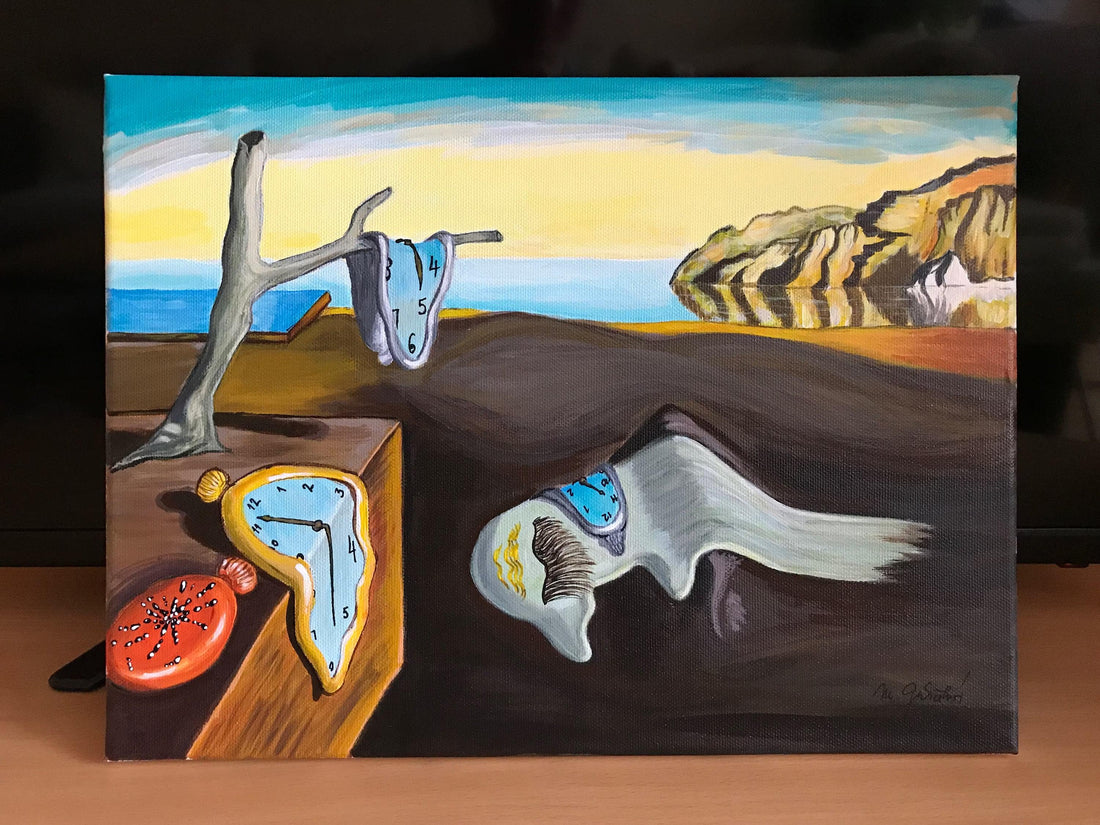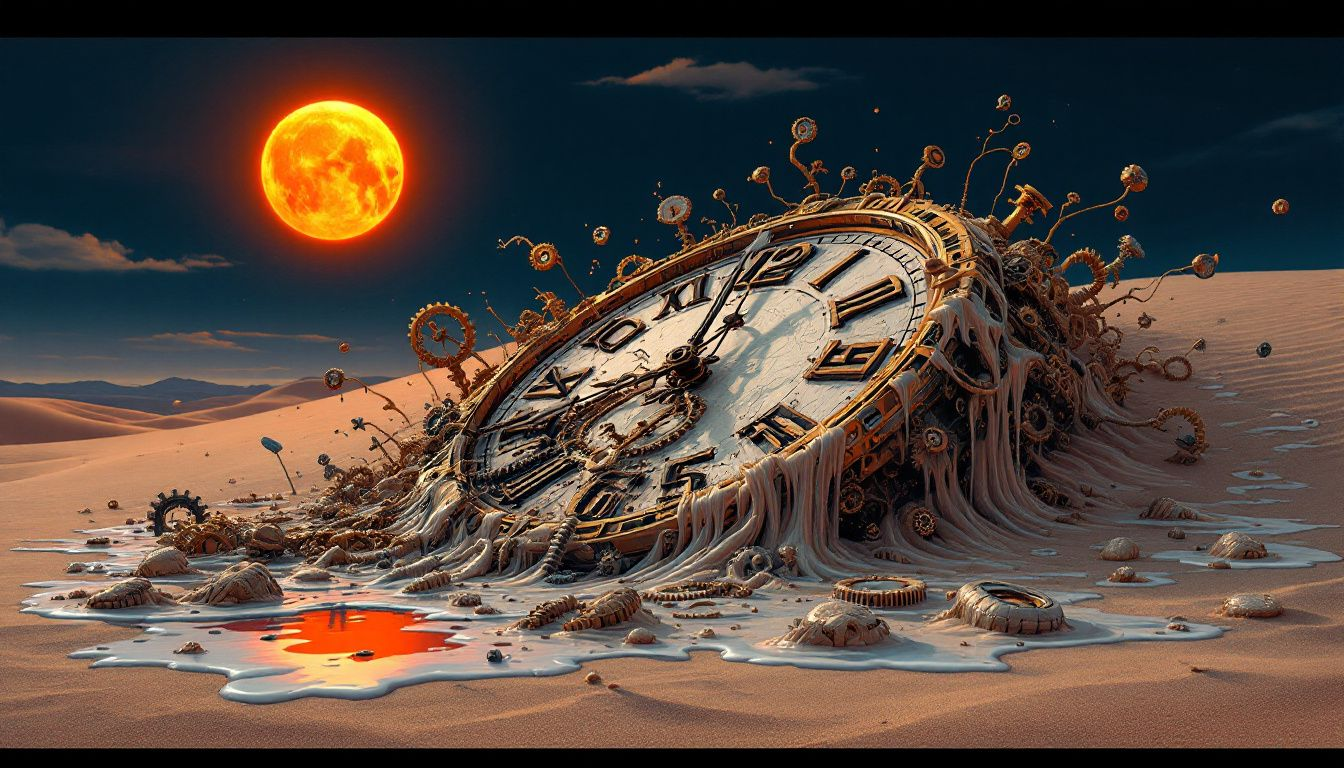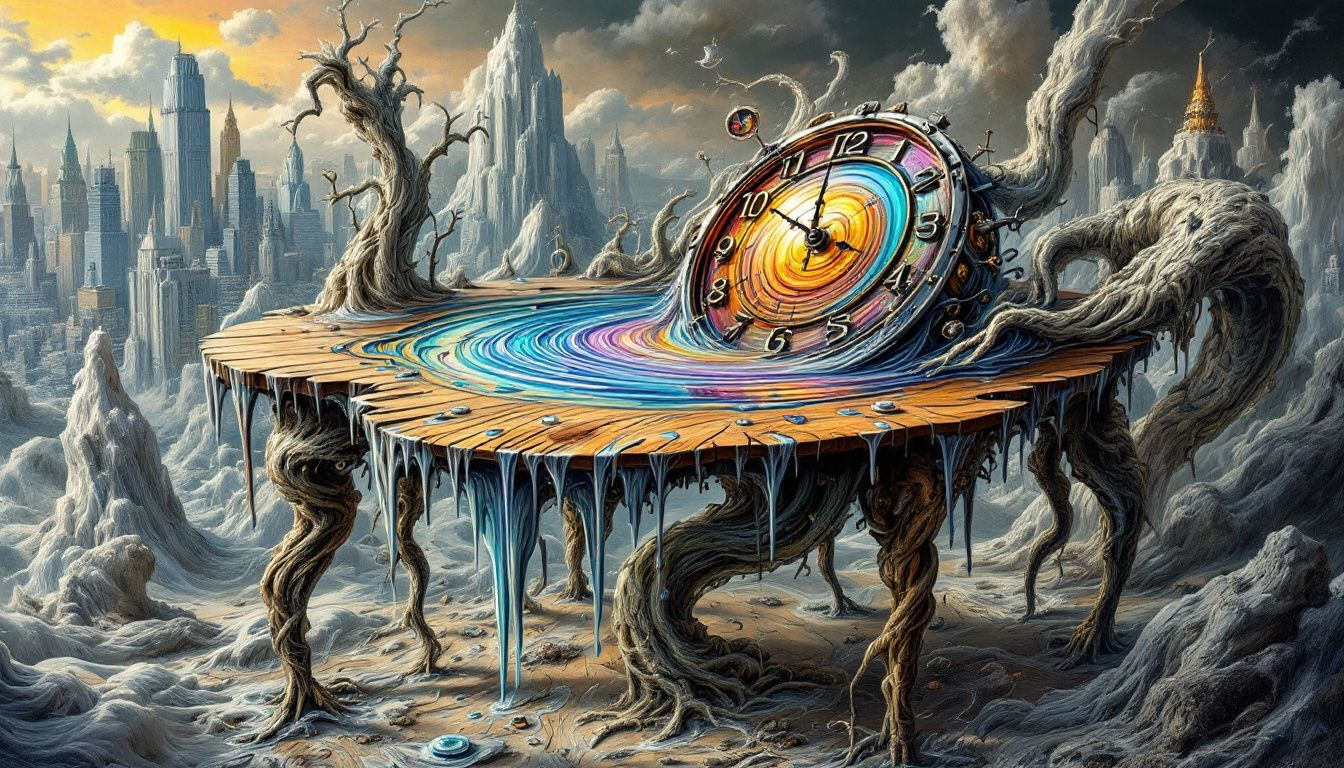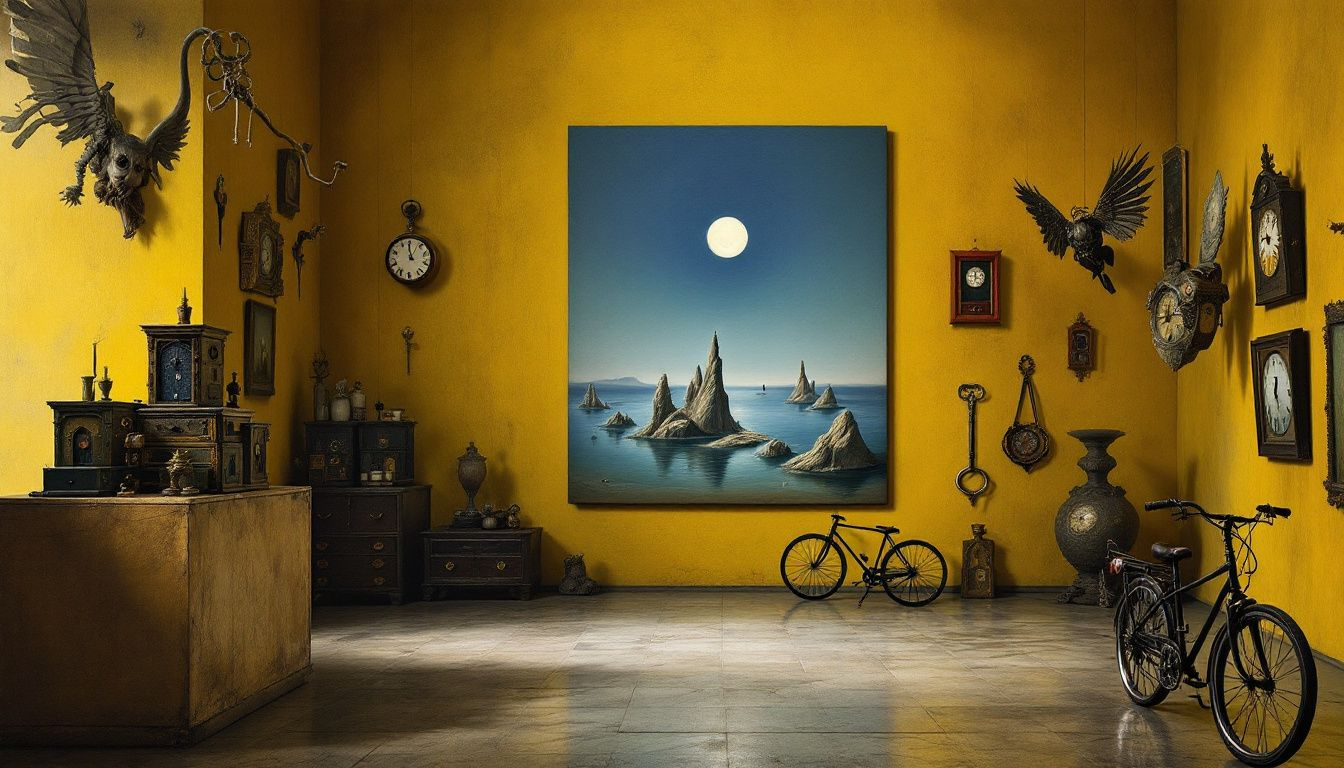
Exploring the Iconic Melting Clock in Modern Art
Share
Exploring the Iconic Melting Clock in Modern Art
Salvador Dalí’s melting clock is one of modern art’s most iconic images, challenging how we perceive time. This article delves into the origins, symbolism, and cultural significance of Dalí’s famous melting clocks.
Key Takeaways
-
Salvador Dalí’s melting clocks symbolize the fluidity and impermanence of time, inspired by everyday observations, such as camembert cheese melting in the sun.
-
The painting ‘The Persistence of Memory’ challenges traditional perceptions of time, encouraging viewers to embrace the subjective nature of reality through surrealistic imagery.
-
Dalí’s iconic melting clocks have transcended art, influencing modern culture and inspiring contemporary artists while being celebrated in museums worldwide.
The Origins of the Melting Clock

The melting clocks in Dalí’s ‘The Persistence of Memory’ are a testament to his unique artistic vision and the surrealist movement’s influence. But where did this iconic motif originate? Dalí’s inspiration came from a blend of unexpected sources, combining elements of everyday life with groundbreaking scientific theories.
Salvador Dalí’s Artistic Vision
Dalí’s artistic approach was a fusion of meticulous realism and dream-like imagery. This method, often described as an art gallery worthy work, allowed him to create scenes that were both fantastical and unnervingly real. Dalí fused reality and dreams to create surrealist motifs that challenge perceptions, inviting viewers into a world where time melts and reality is fluid.
Camembert Cheese Influence
The inspiration for the camembert melting clocks came from an unlikely source: camembert cheese. Dalí observed the cheese melting in the sun and was struck by its soft, pliable form. This visual sparked the idea for the melting clocks, transforming a mundane kitchen moment into a symbol of time’s fluidity and impermanence.
Einstein's Theory of Special Relativity
Einstein’s theory of special relativity played a significant role in shaping Dalí’s depiction of time. The theory suggested that time is not a fixed entity but a flexible dimension, influenced by speed and gravity.
Dalí incorporated this revolutionary idea into his art, using the soft watches to symbolize the malleable nature of time and space.
Symbolism in The Persistence of Memory

The Persistence of Memory is renowned not just for its surrealist beauty but also for the deep symbolism embedded within its elements. The melting clocks are central to this symbolism, representing complex themes that challenge our understanding of time and reality.
Soft Watches as Symbols of Time
The soft, melting watches in Dalí’s painting symbolize the fluidity and impermanence of time. These clocks are not bound by traditional constraints but rather flow and bend, reflecting the subjective nature of time and its influence on human perception.
This iconic surrealist motif has inspired countless artists to explore time distortion in their own works.
Systematizing Confusion
Dalí employed a technique he called ‘paranoiac-critical method’ to create his surrealist images. This method involved inducing hallucinations to merge personal anxieties with surrealistic elements, resulting in fantastical scenes that bewilder and captivate. Systematizing confusion, Dalí encouraged viewers to question their understanding of reality and embrace the irrational.
Human Perception of Time
The melting clocks challenge our traditional perceptions of time, highlighting its subjective and fluid nature. Depicting time as malleable and ever-changing, Dalí invites viewers to reflect on their own experiences and how time shapes their memories and reality.
The Melting Clock in Popular Culture

The melting clock has transcended the canvas to become a widely recognized symbol in popular culture. Its influence can be seen in various forms of media, art, and even fashion, demonstrating the enduring impact of Dalí’s vision.
Art Gallery Worthy Work
Salvador Dalí’s works, especially his iconic melting clocks, are celebrated for their surrealist brilliance and featured in renowned art galleries worldwide. Museums like the Salvador Dalí Museum in Florida and the Dalí Theatre-Museum in Figueres, Spain, offer visitors a chance to experience his masterpieces firsthand, highlighting the global appreciation for Dalí’s contributions to modern art.
Modern Art Interpretations
Contemporary artists continue to draw inspiration from Dalí’s melting clocks, reinterpreting this iconic surrealist motif in innovative ways. Artists like Jeff Koons and Ross Muir have incorporated elements of Dalí’s work into their own, blending surrealism with modern themes and creating new dialogues between past and present.
Iconic Surrealist Motif in Media
The melting clock has become an iconic surrealist motif that transcends its origins in Dalí’s art. It has appeared in films, television shows, and other media, evoking themes of time and surrealism. This widespread influence underscores the melting clock’s cultural significance and its ability to resonate with audiences across different contexts.
Creating Your Own Functional Table Clock Inspired by Dalí

Creating a functional table clock inspired by Dalí’s melting clocks is a rewarding project that allows you to bring a piece of surrealist art into your home.
Here’s how you can craft your own melting clock.
Materials Needed
You’ll need an old vinyl record, a cheap clock mechanism (available at IKEA or Klockit), hot glue, and a baking sheet to create a melting clock.
Heating the record will allow you to shape it into the desired melting form, giving it a surreal appearance reminiscent of Dalí’s iconic design.
Step-by-Step Instructions
Begin by preheating your oven to 220°F and placing the vinyl record on a baking sheet. Bake the record for a few minutes until it becomes pliable. Carefully shape the softened record over the edge of a table to create the melting effect.
Once the record has cooled and hardened, disassemble the clock mechanism and attach it to the record, ensuring the clock hands fit properly.
Adding Personal Touches
Personalize your melting clock by selecting different clock movements, such as a silent mechanism to avoid noise, and adding unique colors, textures, or designs. This allows you to infuse your functional table clock with your own style and interpretation of Dalí’s surrealism, making it a truly unique piece.
Museums and Galleries Featuring Dalí's Works

For those who want to immerse themselves in Dalí’s surreal world, visiting museums and galleries featuring his works is a must. These institutions preserve and showcase Dalí’s artistic legacy, offering a deeper understanding of his creative genius.
Must-Visit Museums
The Dalí Museum in St. Petersburg, Florida, houses an extensive collection of Dalí’s works, including his iconic melting clocks. Other must-visit museums include the Museo Nacional Centro de Arte Reina Sofía in Madrid and the Salvador Dalí Museum in Figueres, Spain, which features the largest collection of Dalí’s works and personal artifacts.
Special Exhibitions
Special exhibitions such as ‘Dalí Alive 360°’ at the Dalí Museum in Florida provide immersive experiences of Dalí’s life and art. Upcoming exhibitions like ‘Writers of Surrealism: Salvador Dalí’ will focus on his literary contributions, offering unique insights into his multifaceted talents.
Virtual Tours
For those unable to visit in person, many museums offer virtual tours. The Dalí Museum’s virtual tour includes a 360° experience of the museum and online exhibits, allowing art enthusiasts to explore Dalí’s works from the comfort of their homes.
Summary
Salvador Dalí’s melting clocks remain a powerful symbol of the fluidity and subjectivity of time. From their origins in surrealist art to their widespread influence in popular culture, these clocks challenge our perceptions and inspire creativity. Whether you visit a museum, create your own functional table clock, or simply appreciate the beauty of Dalí’s work, the melting clocks offer a timeless journey into the surreal.
Embrace the surreal, let your imagination melt, and discover the endless possibilities that lie within the fluidity of time.
Frequently Asked Questions
What inspired Salvador Dalí’s melting clocks?
Salvador Dalí’s melting clocks were inspired by the soft texture of camembert cheese and Einstein's theory of special relativity, symbolizing the fluidity of time. This unique blend of art and science showcases the beauty of imagination!
What do the melting clocks symbolize?
The melting clocks symbolize the fluidity of time and challenge our conventional understanding of reality, reminding us that time is not as rigid as we often think. Embracing this perspective can inspire us to see life’s moments more freely.
Where can I see Salvador Dalí’s works?
You can enjoy Salvador Dalí’s masterpieces at the Dalí Museum in St. Petersburg, Florida, and the Salvador Dalí Museum in Figueres, Spain. It's a fantastic opportunity to immerse yourself in his surreal world!
How can I create my own melting clock?
Creating your own melting clock is fun and rewarding! Just grab an old vinyl record and a clock mechanism, then follow simple instructions to shape the record and assemble your unique creation.
Are there any virtual tours available for Dalí’s art?
Absolutely! You can easily explore Dalí's masterpieces through virtual tours offered by various museums, including the Dalí Museum. Enjoy the art from the comfort of your home!
